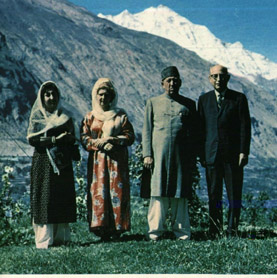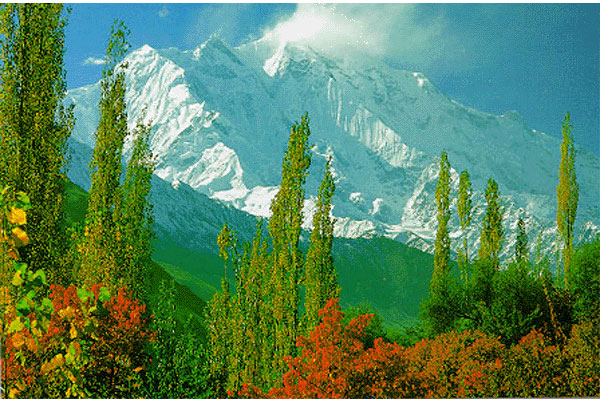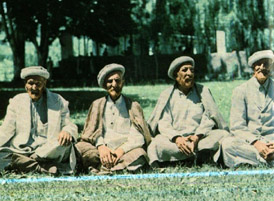 Hunza River Valley was improved in the mid-1950s to accommodate Mir Jamal Khan's newly acquired used Jeep. John Clark traveled on foot and horseback during his visit in 1950 and 1951. Dr. Allen E. Banik travel via Jeep during his visit in 1958 as did others thereafter.
Hunza River Valley was improved in the mid-1950s to accommodate Mir Jamal Khan's newly acquired used Jeep. John Clark traveled on foot and horseback during his visit in 1950 and 1951. Dr. Allen E. Banik travel via Jeep during his visit in 1958 as did others thereafter. The dangerous road was improved over the years to become the Karakorum Highway. This picture is overlooking the village of Ganesh near the capitol of Baltit. The road winds down the side of the valley as it traverses the terraced fields. Rock slides in other areas continue to require constant attention in order to keep the road open.
Hunza is a common destination for tourists traveling to Pakistan because of all of the past hype about the longevity and exceeding good health of the residents. The contrast between the spectacular Himalayan mountain peaks and the lush terraced gardens makes Hunza the photographers' paradise.
A fruit tree in the foreground can be seen in full bloom with a glimpse of the Hunza river in the top left. The tall and narrow Lombard poplar trees have been grown here for centuries because they are fast growing, provide good firewood and don't shade the vegetable gardens.
Hunza exports people. The valley will not support the growing population. Many young adults leave Hunza to other areas of Pakistan for employment. They send money and goods back to their families in Hunza. The farm can be passed to a son but is to small to divide between more than one son.
Tourism provides another source of income. Exports and natural resources are severely limited. Without an export a country or area does not have the money to purchase imports. This economic truth has kept Hunza from progressing.

Summary.
Mir Muhammed Jamal Khan enjoyed a good show of deception. His visit with Dr. Allen E. Banik in 1958 was a good example. The Mir invited Dr. Banik to witness a mock trial in the Old Palace (Fort) that had been built centuries before high on the side of the valley in Baltit. As they left the Mir's new Palace the Mir said "to start without him, as he wanted a little time to dress for the occasion." Dr. Banik and his photographer struggled up the long, steep climb to the Old Palace and rested for a couple of minutes before entering. They were shocked to find the Mir of Hunza seated on his throne beautifully attired in his ceremonial robes, plumed cap and ancient sword. Dr. Banik had a 15 minute head start, but the Mir sat cool and comfortable, with no sign of fatigue. Dr. Banik ask if the Mir had come by horseback. He replied laughingly, "Why, of course not! I walked - it was just a short jaunt." Naturally, the Mir has ridden a horse. This was a show of deception attempting to trick Dr. Banik into believing the people of Hunza were super-human. Dr. Banik believed the trick by convincing himself and the readers that it was possible because the Mir had a longer stride. See Dr. Banik's book page 107. The scientific fact is that having a longer stride does not reduce the work required to hike the hill. Short-legged people do very well climbing mountains. Dr. Banik must have failed his college physics class.
We really shouldn't fault the Mir for deceiving people about Hunza. It is always a strong temptation to play with the minds of the gullible. He did a first-class act on them. The Mir also said there were Abominable Snowmen in the mountains around Hunza, and Dr. Banik apparently believed that as well.
The Scientific American Mind magazine in the July 25, 2005 issue ran a front page story titled, The Joy of Telling Lies - Everybody Does It - Because It Works. Deception runs like a red thread throughout all of human history. The Hunzakuts were no different. The Hunzakuts excelled in falsehoods about their ages, state of health and happiness because they benefited. The Mir encouraged the deception because he thought the people would be happier. The Mir prevented John Clark from taking two students to the United States for further education because the Mir feared the boys would be dissatisfied in Hunza after their return. He was shielding his people from the world.
Hunza was not a democracy as falsely reported. The Mir (King) was a strong dictator. His meetings with the ministers from each village was called a Durbar where the ministers brought up concerns and problems. The Mir ask for their opinion but in the end they were simply "yes" men. The Mir had such control over the subjects of Hunza that a farmer refrained from correcting the river channel when the river had begun eroding his farm land. The farmer had to get permission from the Mir before trying to save his farm.
 The Hunza people did not enjoy exceptionally long life as falsely claimed. It is doubtful that anyone in Hunza ever lived to be 100 year of age. The ages claimed by the Hunzakuts were simply lies. They considered age to be a matter of wisdom and achievement, not calendar years. They kept no written records and did not know their calendar age.
The Hunza people did not enjoy exceptionally long life as falsely claimed. It is doubtful that anyone in Hunza ever lived to be 100 year of age. The ages claimed by the Hunzakuts were simply lies. They considered age to be a matter of wisdom and achievement, not calendar years. They kept no written records and did not know their calendar age.
This picture was taken in 1961. Queen Rani is on the left. Mir Jamal Khan is third from the left. His age was accurately known because he was royalty. He was born on September 23, 1912 and died in Gilgit, Pakistan on March 18, 1976. He was only 49 when this picture was taken but looks much older. He only lived to age 64. He certainly was not a symbol of longevity.
The Hunza people were not healthy or free from disease. They suffered greatly from a multitude of disease. They had poor dental health and infections. They lived in a very unsanitary environment. The one benefit was the extreme isolation that reduced the number of contagious diseases. Cancer and heart disease may have been rare, but it is unknown for certain because the dead were never examined by a professional.
The Hunza diet was not the perfect diet as claimed. Diet deficiencies abound. The diet was seriously deficient in iodine, omega-3 fatty acids and amino acids from proteins. Many of the diseases treated by John Clark were the result of the a nutritional deficiency.
Tuberculosis is a good example of a disease that causes death for those with a protein deficiency. The Hunzakuts suffered and died from tuberculosis as reported by John Clark. The immune system is made entirely from amino acids derived from eating protein. Meat is the best source for amino acids. The Hunzakuts developed tuberculosis and died as a result of protein deficiency. Dr. Weston E. Price in the 1920s and Arctic explorer Vilhjalmur Stefansson in the 1910s discovered that Eskimos who developed tuberculosis while living in the white mans' settlements and eating carbohydrates were cured after being transferred to live with the natives on their traditional all-meat diet. Moving the sick Eskimos out of the settlements to return to the native way was a proven cure for diseases.
The Hunzakuts were not a wonderfully happy people as claimed. The women in Hunza were treated harshly. They were not allowed an education and were highly restricted in public. The women endured hard labor in smoky dwellings and suicide was not uncommon. They would either eat the poison pits from the bitter apricot or jump from a convenient cliff.
The grains did not mature faster in Hunza than other places as false reported by Dr. Allen E. Banik. The vegetation and trees in Hunza showed signs of nutritional deficiency as reported by John Clark. Hunza is an artificial environment that depends on hard manual labor to keep the terraced gardens watered and fertilized. The silt used to make the gardens is not organic soil. It is ground rock that originates from the grinding of the glacier as it moves down the high mountain valley above. The silt contains many minerals but lacks phosphates and organic matter. Fertilization with animal dung and human excrement is required several times during the growing season to keep the plants and trees healthy. Even so, the growing conditions are not ideal. Luckily the glacial milk does not contain harmful minerals or metals in sufficient quantities to cause health problems for the vegetation, animals or humans. No two glacial milks are the same. Glacial water from other areas of the earth are each different from one another. The content depend completely on the composition of the rock over which they flow.
The Hunza people were no different from other people who lived in isolated high mountain communities. Most of the books written about the Hunzakuts are simply fiction and myths flamed on by the imagination into believing the Hunza River Valley was a magical Garden of Eden where people never got sick. The people of Hunza recognized a century ago that pretending to be centenarians brought visitors bearing money and gifts. They certainly must have been laughing after retreating to the privacy of their homes. Primitive people the world over have been known to tell tall tales about themselves to strangers visiting their land. Lying about one's age is as old as mankind. The people of Hunza are known for their consistent exaggerations of age in order to gain respect and social status. The social structure of Hunza encouraged lying and cheating as a profitable way to better one's self.
Scientific facts about Hunza have been impossible to obtain. Since the British first entered Hunza the ruling Mir has placed a severe restriction on visitors to the valley. Permission was required from both Pakistan and the State of Hunza. Scientific studies or independent investigations were strictly forbidden. An invitation from the Mir of Hunza was essential to obtain a special-entry permit. As late as 1960 there were no hotels, no restaurants, and no stores to buy food. Chosen visitors were generally guests of the Mir in the capital of Baltit where they were a make-believe story instead of the truth about Hunza.
The Mir of Hunza never provided verification of the longevity of the Hunzakuts and never allowed others to investigate. The Hunzakuts of the past were no older than they appeared and may have actually been younger than they appeared. The longevity was a hoax from the beginning, and the diet did not produce a super-human race. Hunza could best be described as an isolated high mountain kingdom founded on betrayal and struggling for existence by deceiving the world.
Hunza has been mostly ignored by the surrounding nations because it has no strategic importance whatsoever. The valley is simply inconsequential except for the myth that the people had record longevity on a near vegetarian diet. However, the Hunza River Valley did provide many health benefits. The Hunza people of the past were forced to adopt a lifestyle that has been shown to have many healthy features.
-
Babies were nursed at the breast for several years. The weak and those that could not nurse simply died.
-
Obesity caused by excessive calorie consumption was unknown, although malnutrition was a serious problem.
-
Work and physical activity aided in overall well-being.
-
Isolation prevented many communicable diseases.
-
Dry air at a high elevation reduced the incidence of many communicable diseases.
-
Rodents and insects that transmit disease were rare in the isolated high mountain valley.
-
Processed and refined foods were non existent.
-
Sugar was a very rare commodity in 1950 because of the extremely high cost and unknown earlier.
-
Honey was not available.
-
Imports were unavailable because of the isolation and the lack of any exportable commodity.
-
Everyone struggled equally. There was not an overworked slave class or lazy ruling class in the social structure, both of which tend to reduce life span.
Many people have tried to capitalize on the Hunza myth by writing books and selling diet programs. Many of these people actually believed the Hunza myth themselves and tried to duplicate the diet in their own lives. The result was always failure. Good health was never achieved. A typical fraudulent diet program called the "BioCalendar Health System" was advertised in The Kansas City Times on May 18, 1978, on page 18D by a group calling themselves The American Health Institute, 125 American Health Institute Boulevard, Canton, Ohio, 44767.



 The Hunza people did not enjoy exceptionally long life as falsely claimed. It is doubtful that anyone in Hunza ever lived to be 100 year of age. The ages claimed by the Hunzakuts were simply lies. They considered age to be a matter of wisdom and achievement, not calendar years. They kept no written records and did not know their calendar age.
The Hunza people did not enjoy exceptionally long life as falsely claimed. It is doubtful that anyone in Hunza ever lived to be 100 year of age. The ages claimed by the Hunzakuts were simply lies. They considered age to be a matter of wisdom and achievement, not calendar years. They kept no written records and did not know their calendar age.



 This picture shows old Hunza men who proclaim to a visitor that they are more than 100 years of age. They appear to be 70 to 80 years of age which would be more accurate. Because this is a recent picture taken by tourists, these gentlemen were probably never born or raised in Hunza. They most likely arrived from other areas of Pakistan, drawn to the opportunity of collecting a gratuity from the unsuspecting traveler for the privilege of taking their picture.
This picture shows old Hunza men who proclaim to a visitor that they are more than 100 years of age. They appear to be 70 to 80 years of age which would be more accurate. Because this is a recent picture taken by tourists, these gentlemen were probably never born or raised in Hunza. They most likely arrived from other areas of Pakistan, drawn to the opportunity of collecting a gratuity from the unsuspecting traveler for the privilege of taking their picture.